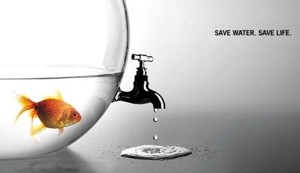You’ll quickly realize how often and easy it is to waste water. It’s pretty easy to leave the tap running longer than is actually necessary.
The Calculator is an important tool that will help you complete these Challenges. Before you accept the Challenge you should calculate your current usage. You can see your progress by adding new values daily into the Calculator and deleting previous entries. Items can be deleted from the Calculator list by swiping over the entry.
In order to achieve your target consumption of 80 liters a day you’ll need to reduce your water usage across multiple aspects of your life.
Bath
Personal hygiene: Don’t take baths (150-180 l). Try to shower efficiently an turn off the water while you soap yourself (30 l).
Washing you hands: Turn off the faucet while you soap your hands. This will save around 70% of the water.
Brushing your teeth: Turn off the faucet while you brush your teeth and use a glass to rinse when your done (uses 2 l instead of 40 l with a running tap).
Shaving: Fill the sink half full and use to rinse your razor blade (uses 4 l instead 80 l with a running tap).
Gaskets: Make sure all your gaskets are in working order and none of your faucets are dripping (a dripping faucet uses approximately 17 l per day).
Toilet
Use the stop button: If your toilet doesn’t have one, it might be time to think about upgrading.
Don’t use your toilet as a trash can: Food waste, Kleenex and medicine belong in the trash can and not in the toilet, every flush counts.
Make sure your flush is working properly: Leaks in your flush can cause water to be wasted.
Use rainwater: Installing a rainwater collection system can help you save up to 50% of your household water usage.
Kitchen
Washing up: Don’t wash your dishes under running water (uses 20 – 30 l instead of 170 l).
Dishwasher: Wait until the dishwasher is full before running or use the small load setting.
Cooking: Wash your fruit and vegetables in a bowl and reuse the water to clean or water your plants.
Tea and coffee: Only heat the amount of water needed.
Drinks: Put water in the fridge to cool down instead of letting the tap run.
Laundry
Full load: Make sure that you always fill up the machine or use the half load setting.
Pre-wash: Try and avoid using the pre-wash.
Airing: Certain materials don’t have to be washed after every wear. A day in the fresh air can work wonders.
Hand wash: Don’t hand-wash under running water. Adding a little vinegar to the water will help remove any soap residue from fabric.
Washing machine: It might be time for a newer, more efficient model.
Home and car
Car wash: Try to find a car wash that recycles their water and uses environmentally friendly products (uses around 10 l of fresh water).
Wash your car at home with a bucket and sponge.
Sweep your driveway with a broom instead of hosing it down.
Clean up small messes in the kitchen and bathroom sooner rather than later. This prevents the need for large amounts of water and detergent.
Using micro-fibre cloths to clean requires significantly less water.
Garden
Use rainwater: Perfect for your plants and saves drinking water.
Flowers: Try to water your flowers in the morning or evening and aim for the roots!
Schedule: Water your plants less often but with a little more water than usual.
Lawn: Place a glass near your sprinklers. Once it has 2cm of water in it turn off the sprinklers for 3-4 days.
Rule of thumb: If the grass stands up by itself after being flattened then it doesn’t need to be watered.
Pool: Cover your pool so that you don’t lose water to condensation. Make sure you don’t have any leaks.
